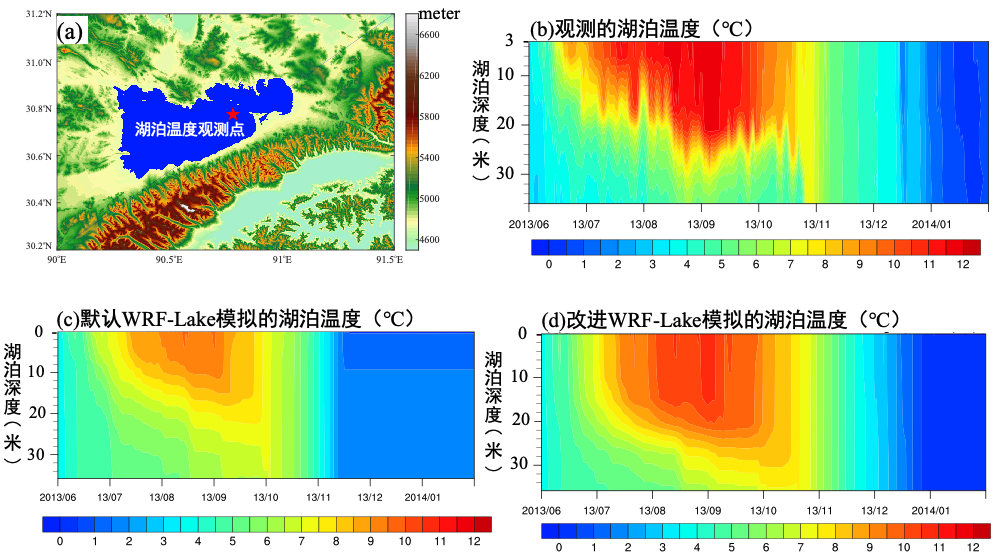The lake area on the Tibetan Plateau (TP) accounts for over 50% of the total lake area in China. With the area of alpine lakes constantly increasing, more and more attention has been paid to the impact of lakes on local weather and climate. However, the lake freeze onset simulated by the available mode is seriously too early (antedating by 1~2 months), which problem can hardly be addressed by relying on the very limited observation data of alpine lakes alone. Yang Kun’s Research Group of the Department of Earth System Science (DESS), Tsinghua University has, on the basis of improving the parameterization scheme of the lake-air coupled model, directly realized the reasonable simulation of the lake thermal regimes and lake freeze onset and clarified the relative contribution of lake surface water-heat exchange and internal thermal processes. The research results have been recently published in Journal of Geophysical Research: Atmospheres as an article titled “Importance of Parameterizing Lake Surface and Internal Thermal Processes in WRF for Simulating Freeze Onset of an Alpine Deep Lake”.
With Lake Nam Co, the second largest lake in Tibet Autonomous Region, as an example, the ability of WRF-Lake, a lake-air coupled model, to simulate the thermal state of alpine lakes is evaluated. The observations of the lake temperature profile show that the surface energy of the lake can be transferred to the deep layer in summer (Fig. 1b), and the lake does not freeze until January 10th (Fig. 2a). However, the simulated lake water temperature is lower (Fig. 1c), and the lake begins to freeze as early as November 13th (Fig. 2a), which indicates that the energy from the surface of the lake in the model is difficult to transfer down, while the lake-atmosphere interactions are too strong.
To solve these problems, addressing the heat release and storage stages of the lake, the effects of surface water-heat exchange and internal thermal processes of the lake are separated in the model. In the heat release stage (from November to freeze onset), the lake water is completely mixed, and the thermal condition of the lake has nothing to do with the internal thermal parameters, but largely depends on the surface water-heat exchange. Therefore, this research draws on the parameterization scheme of lake surface water-heat exchange developed by Researcher Ma Yaoming’s Research Group of the Institute of Tibetan Plateau Research, the Chinese Academy of Sciences, based on field observations. In the heat storage stage (June-October), the thermal stratification of lake water depends on the internal process parameters (extinction coefficient of lake water and temperature of maximum water density). These parameter values come from field observations of Zhu Liping, a researcher from the Institute of Tibetan Plateau Research, Chinese Academy of Sciences. With the introduction of the improvement of the two stages of heat release and storage in the lake into the coupled model, the simulated lake temperature (Fig. 1d) and the lake freeze onset obviously approximate the observed values (Fig. 2a), indicating the significant improvement of WRF-Lake's ability to simulate the thermal regimes of the lake.

Fig.1 Lake Nam Co (a) Geographical location, with color denoting the terrain height, and red star representing the location of lake temperature observation; (b) seasonal change of lake temperature observed; (c) seasonal change of lake temperature with default Lake (WRF-Lake) simulation, and (d) seasonal change of lake temperature simulated with improved WRF-Lake.
Next, the research, through sensitivity value experiments, further discloses the relative importance of the surface water-heat exchange of internal thermal processes of alpine lakes on the simulation of lake freeze onset. The introduction of the new scheme of lake surface water-heat exchange parameterization substantially weakens the release of turbulent heat fluxes from early summer to late autumn, thus significantly delaying the lake freeze onset timing. On the other hand, the introduction of observations of the parameter of the internal processes of the lake mainly weakens the release of turbulent heat fluxes from June to September (Fig. 2b), but with relatively little impact. Therefore, the lake surface water-heat exchange scheme plays a more important role in the simulation of lake-atmosphere interactions.

Fig. 2 (a) Comparison of observed and simulated freeze onset timing of Lake Nam Co; (b) The change of lake turbulent heat fluxes of lake internal process parameters and lake surface water-heat exchange schemes at different stages (diagrams modified based on the article)
The distinct hydrothermal characteristics of lakes and land lead to their strikingly different meteorological conditions. A lake model driven by the meteorological data observed on the lakeshore may produce simulation results subject to great uncertainty, resulting in deviation in the understanding of the physical processes. Therefore, this study chooses to carry out the analysis directly under the framework of lake-atmosphere coupling.
Ma Xiaogang, a postdoctoral fellow of the DESS, Tsinghua University, is the first author of the article, and his co-supervisor Professor Yang Kun is the corresponding author. Other co-authors of the article are from the DESS, Tsinghua University, the Institute of Tibetan Plateau Research, the Chinese Academy of Sciences and Tibet University. The research is supported by the National Natural Science Foundation of China (41975125 and 41701041) and the “Project of the Center for the Earth System Basic Science on the Tibetan Plateau” (41988101).
Full-text link: https://agupubs.onlinelibrary.wiley.com/doi/10.1029/2022JD036759